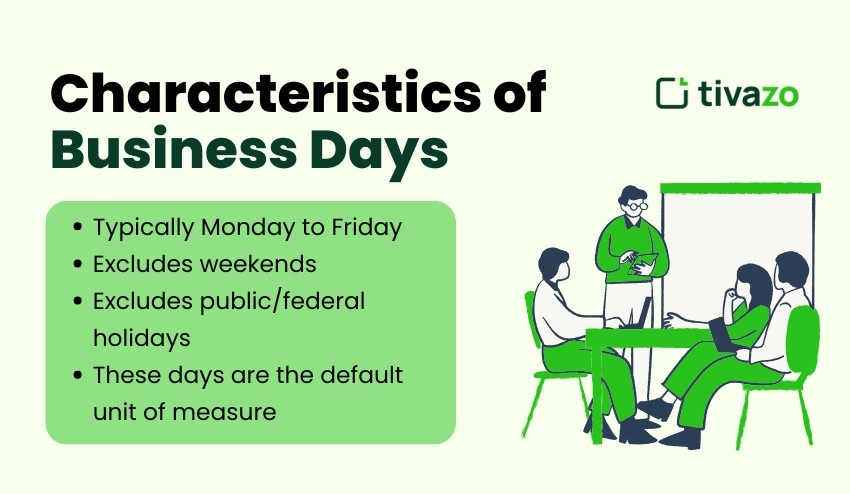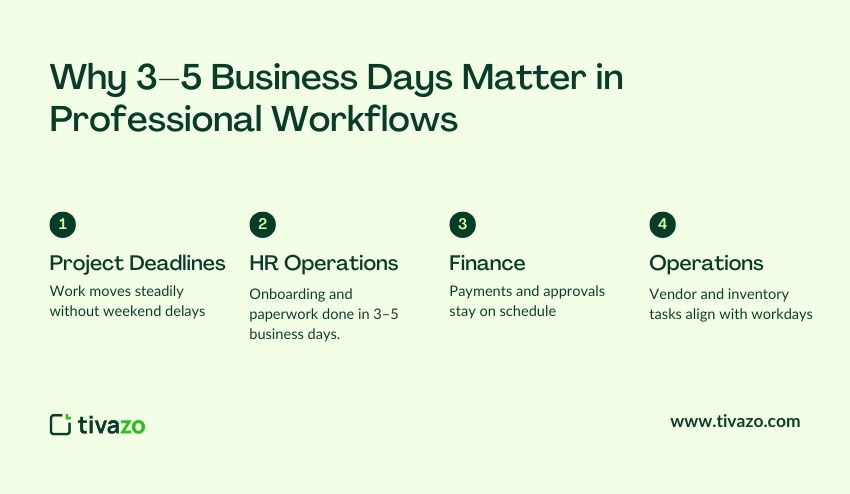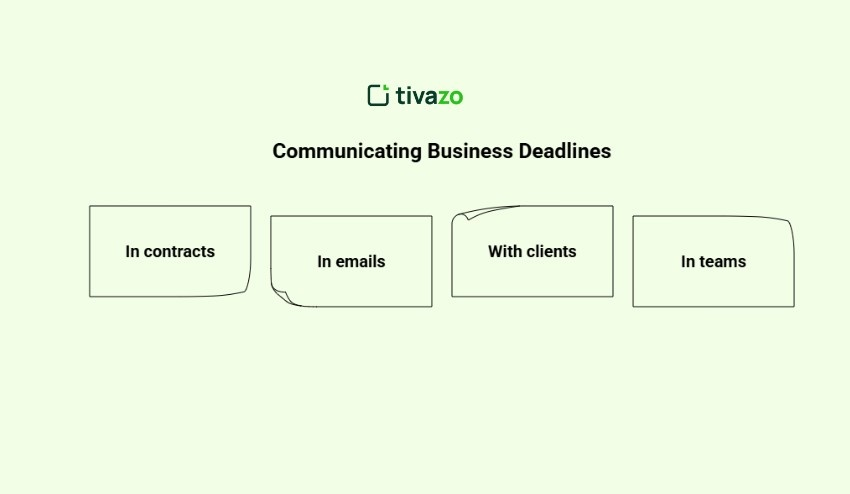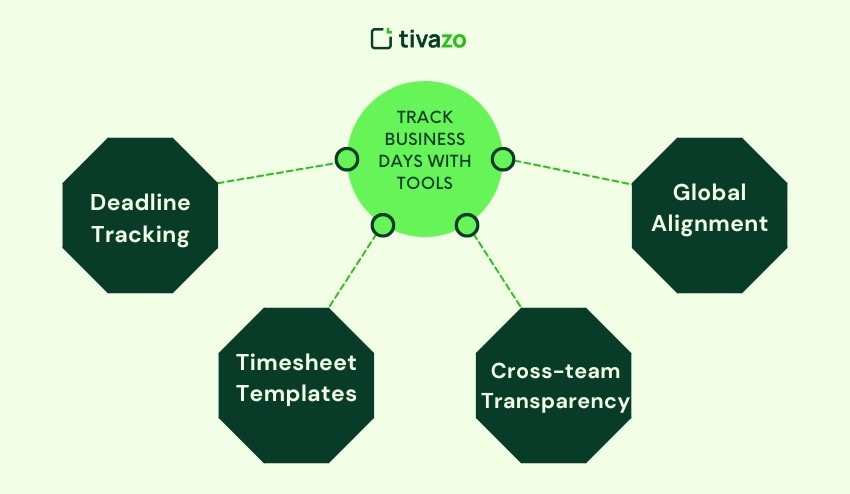Consider this: your manager has stated, “I need you to submit the report within 3-5 business days.” You pause for effect—what does that even mean? Is it half a week? A full week? What about weekends and holidays? Confusion like this occurs every day in workplaces across the globe, causing missed deadlines, angry teams, and poor planning.
Recognizing how long 3-5 business days actually is has serious ramifications on work planning, project management, HR work, and finance processes. In this guide, we will break it all down from definitions to real example, and how tools like Tivazo can make business days management a breeze.
Key Highlights:
- What Are Business Days
- characteristics of business days
- How Long Is 3–5 Business Days
- 3–5 Business Days in Professional Workflows
- Misunderstandings About Business Days
- Role of Business Days in Project Planning
- Track Business Days with Tools
What Are Business Days?
Business days are the approved days of operation for most organizations, usually from Monday to Friday, and excluding weekends and holidays. Business days are not calendar days, which are every day of the week. Business days represent when companies, governments, and banks are open and operational. They also allow an agreed-upon common reference point when establishing the timeframe for contracts, financial transactions, and deadlines in the workplace. Practically, this means business days are used to allow organizations and individuals to set expectations on when items will be completed and when they can officially act.
Key characteristics of business days:
Business days have a few characteristics that make them important for planning and operations across various businesses and industries. These days provide consistency in how companies schedule workloads, process requests, and deliver outcomes, which serves as a reference point for all to maintain expectations about timing.

- Typically Monday to Friday.
- Excludes weekends (Saturday and Sunday in most countries).
- Excludes public/federal holidays.
- These days are the default unit of measure for contracts, deadlines, HR activities, and project planning.
👉 Example: If your HR team states they will process an onboarding document in 3 business days, and you submit it on a Friday, it will be processed the following Wednesday (assuming no holidays in between).
How Long Is 3–5 Business Days at Work?
When someone says “3–5 business days”, they are generally talking about a time frame that runs from half a work week (3 days) to 1 full week (5 days). This subnet, or wait time, does nominally exclude weekends and, additionally, Public Holidays. Therefore, the actual wait time may be longer than you think. As in, if you were assigned a task on Thursday and had a 3-business-day deadline attached, you would actually have until the following Tuesday.
Understanding this allows employees, managers, supervisors, and project members to set the right expectations and minimize confusion surrounding deadlines.
3 Business Days → About half a work week.
5 Business Days → A standard work week.
Example Calculation
It is helpful to understand the math related to business days, as timelines can often feel like they take longer to meet because of weekends and holidays, because a timeline that looks short on paper may stretch to another week in reality. So it is helpful to see a quick example to depict just how deadlines change based on a start date.
| Request Date | +3 Business Days | +5 Business Days |
|---|---|---|
| Monday | Thursday | Next Monday |
| Wednesday | Monday (next) | Following Wednesday |
| Friday | Wednesday (next) | Following Friday |
👉 Notice the impact that weekend days may have on the timeline.
Business Days vs. Calendar Days
This is often where confusion comes into play: Business days ≠ , Calendar days.
- Business days = Workdays (Mon-Fri, Holidays not included).
- Calendar Days = Every day in the week, both weekdays and weekends. Holidays included
Calendar days get longer without question; however, business days follow the cadence of an actual workplace. So, a deadline that is tied to business days is often much more practical for teams to work together, resource alignments, and maintain accountability across departments.
👉 Example: If a task is due on calendar day 5, starting Friday it is due on Wednesday. If it is due on business day 5 it is due on the following Friday.
Why 3–5 Business Days Matter in Professional Workflows
The notion of business days is integrated into just about every aspect of workplace operations. Here’s what this means:

- Project Deadlines: Numerous tasks, approvals, and sprints run on a business-day basis. A “5 business day” sprint equates to a full workweek, and keeps project managers on track toward deliverables without weekends messing with fixed schedules.
- HR Operations: Payroll, onboarding, compliance documents, and other HR operations usually happen within 3–5 business days. For example, when a newly hired employee submits their paperwork on a Monday, the HR department expects this amount of time to verify documents, create system access, and complete compliance checks.
- Finance: Approvals, transfers, and reimbursements are counted on business days. A vendor payment marked for “within 5 business days,” gives the bank, and accounting enough time to rest assure everything has been accounted for correctly without weekend delays.
- Operations: Processes such as vendor procurement and inventory usually work in business-day cycles. This makes it easier for the employer to contract or fulfill with their vendor and timeline, along with their vendor’s timeline, so shipments, approvals, contracts, etc. actually are working during a workday and won’t be delayed due to the weekend.
Common Misunderstandings About Business Days
Business days remain a commonly used term but there are still some common misconceptions about business days that can cause confusion and operational issues.
- Treating business days as calendar days → Many employees or clients take 5 days to mean 5 calendar days, which causes problems with deadlines and with expectations, especially when factoring in weekends or statutory holidays.
- Overpromising to clients → Telling a client that something is “delivered in 5 days” not qualifying “business days” is just setting up a dispute or reduced trust if the client was expecting something much quicker than is possible in the operations of having a reasonable turnaround.
- Contract ambiguity → Legal, and HR compliance agreements that are not precise have the potential to create compliance issues, late payments and disputes regarding project milestones, because no applicable shared understanding has been created to have a core understanding of when actions are to take place.
Establishing clarity on what constitutes a business day is likely to improve the chances of avoiding misunderstandings and therefore, improving operational efficiencies.
Business Days in Global and Industry Contexts
Business days vary world-wide and having awareness of the difference in local context and industry standards can make a big difference in effective planning and communication. Global companies will need to incorporate the regional work weeks and holidays into the planning processes in order to avoid confusion and delays when setting proposed timelines and deadlines.
- U.S. & Europe: Business days are generally Monday to Friday, National holidays excluded.
- Middle East (e.g., UAE): Sunday-Thursday Business week, while Friday and Saturday are considered the weekend so that everyone gets a break.
- Asia: Most countries are similar to the U.S. However, public holidays can vary between the countries so that affects business days.
In some industries (i.e. Healthcare – hospitals, tech support, retail), business days are flexible to the point of operating flat out over the weekend. People will have to be clear about which days they’re counting in their calculations.
👉 Global teams will need to synchronize on local calendars and industry standards to mitigate problems around deadlines and smooth project delivery.
The Role of Business Days in Project Planning
Business days ultimately drive the scheduling and implementation of projects, forming the foundation of realistic schedules and successful staff collaboration. Skipping business days can cause your projects to miss deadlines or get into a resource conflict, and it can make them take longer than you expect.
- Sprint cycles are organised around working days to make sure the team’s availability matches the tasks to be completed. This enables agile teams to follow the progress advanced without being interrupted by weekends/holidays.
- Tools such as Gantt charts (and more robust project management systems, in general) depend on workweek structures so that timelines and dependencies can be displayed correctly.
- Holidays are bottlenecks that, if left out of your schedule, can lead to delays in approvals, deliverables, and your entire project.
How to Communicate 3–5 Business Day Deadlines Clearly
If you say 3–5 business days, per these sorts of discussions, clear communication is required from product and marketing teams so that there is consensus on timelines and expectations. Misunderstanding can result in early/late deliveries, frustration, and operational inefficiency. Tools like AI-powered 360 feedback software can help teams stay aligned by highlighting communication gaps and improving collaboration across departments

- In contracts, always use “business days” to avoid potential legal complications and ensure everyone is on the same page.
- In emails: Give a deadline date and time (for instance, “Due by Friday, March 14”) as opposed to saying 3–5 business days, so the recipient knows when the assignment is due.
- With clients: Employ clear language: “So that means by this time next Wednesday, weekends and holidays not included,” to align expectations and avoid disputes.
- In teams: Use project-management tools that do the math for you, accounting for business days, helping everyone stay on the same page, and preventing errors that are manual-induced.
By applying these practices, organizations can maintain clarity and accountability across projects, teams, and client interactions.
Practical Tips for Managing Business Days Better
Managing business days, when done right, can greatly enhance your project scheduling, team coordination, and ultimately your client’s satisfaction. When you implement a few of the following operational strategies, it can help you make timelines practical and operational.
- Use project tools that calculate deadlines automatically: This will prevent many miscalculations and allow your timeline to match actual business days to avoid manual or missed deadlines.
- Factor in local holidays when working across borders: Each country has its own public holidays that may impact deadlines related to international work. Make time for these holidays not to add any surprises to deadlines.
- Build internal deadlines earlier than client-facing ones: Having a cushion for you and your team to make revisions and get approvals for work can save the project from missing deadlines due to things like unplanned delays.
Whether or not you implement any or all of these tips, you will find that business day management will operate smoothly, reduce miscommunications, and adhere to timelines even in chaotic work environments.
Track Business Days with Tools
Calculating business-day deadlines on your own can lead to confusion, missed tasks, and misunderstandings about due dates. Using tools designed for deadlines can provide consistency and accuracy for staff, projects, and teams.

- Deadline Tracking: Automatically factors in weekends and holidays by calendar, providing accurate due dates that allow teams to honour deadlines with relative certainty and without confusion about weekly progress.
- Timesheet Templates: Timesheet templates, either weekly or monthly, that reflect standard business day workweeks and holidays, provide a way to track both hours worked and adherence to planned goals for projects.
- Cross-team Transparency: It allows team members to see the same business-day deadlines, which can lead to greater coordination and central accountability for workload, timeliness, and improvements to workflow.
- Global Alignment: It includes accommodation for the different working weeks and holidays for team members. Accounts for differences between regions so work gets done without conflict or delays that impede their ability to complete projects on time across multiple regions.
Enhancing Client Trust Through Transparent Business-Day Commitments
Exactly stating timelines in business days fosters credibility and trust with clients. When clients always know when to expect deliverables, there is a reduction of disputes, increased satisfaction, more confidence during negotiation, and greater understanding with respect to contracts and long-term relations.
- Increased satisfaction and loyalty from clients.
- Increased understanding with respect to contracts and agreements.
- Increased planning for client deliverables.
- Greater long-term professional relationships.
Conclusion
Although “3–5 business days” may seem quite simple, it is not taken lightly in a professional sense. 3-5 business days ultimately determines payroll cycles, project sprints, compliance timelines, etc.; and if this ever gets misconstrued misinterpretations can result in missed deadlines, compliance issues, and unhappy teams. 3 business days usually refers to about half of a week of work 5 business days refers to a week of work, always citing avoiding weekends and public holidays. With enough planning and useful tools like Tivazo for automatically counting business days, organizations can manage expectations and deliverables with similar understanding, manage projects with ease, and relieve any misunderstandings around timelines to create better workflows, and predictability of depicts.




